Sometimes a woman’s ovarian function can be altered reducing her possibilities of generating an egg with sufficient quality to conceive. Egg donation is the technique with greater pregnancy success rate and is done via In Vitro Fertilization (IVF) using eggs from young healthy donors who have adequate ovarian characteristics.
The procedure consists of the union of the eggs and spermatozoids from which the embryos which will be selected and transferred to the maternal uterus are generated. This treatment makes it possible for some women to become mothers that otherwise would not be able to.
When is it necessary?
- Women without ovarian function, identifies those women who lack menstruation:
· Premature ovarian failure considers those situations in which menopause occurs before the age of 40, causes are very different including genetic factors, surgery and oncologic treatment (chemotherapy and radiotherapy).
· Primary Ovarian failure includes those situations of genetic and developmental defects which do not permit the appearance of menstruation since puberty (pure gonodal dysgenesis: 46XX, Turner Syndrome: 45XO, Swyer Syndrome: 45XY, Savage Syndrome).
- Some women, who although present ovarian function, when using their eggs there could be greater risks of difficulties to give birth to a healthy newborn baby:
· Women who carry some kind of hereditary disease that cannot be made by preimplantional genetic diagnosis (PGD).
· Woman with inaccessible ovaries to make the extraction of the eggs.
· When previously there has not been success in repeated attempts of In Vitro Fertilization (bad egg quality, low response and implantation failure).
· Women with a history of repeated miscarriages.
· Women older than 40 years that even having an ovarian function are in an advanced age that does not permit to obtain a good number of quality eggs or even greater risk of down syndrome.
What are the steps of an Egg Donation Treatment?
1. The couple has to be examined in detail. The Doctor will consider series of necessary tests to carry out the treatment. In the case of the male it will be necessary to make a basic study of his semen and when convenient a sample of sperm will be preserved. If it is necessary to optimise the procedure or any doubts arise, more tests will be carried out.
2. The recipient will be subjected to an endometrial preparation treatment. The endometrium is the tissue which will directly contact with the embryo at the moment of the implantation and it is necessary to synchronise its growing with the embryonic development. The treatment is very simple and consists of emulating the hormonal changes which take place in a physiological way during a menstrual cycle.
3. Selection of the donor according to the physiological characteristics and blood group of the couple. Previously; the clinical evaluation would have been made in virtue of what is stated in the Spanish law decree 14/2006 of assisted reproduction and the 1998 report by the National Commission of Assisted Human Reproduction.
4. After this process the donor will be treated to develop the process of the necessary controlled ovarian hyper stimulation and later she will be submitted to surgery to obtain the eggs.
5. The eggs are prepared to be inseminated; it can be by means of conventional In Vitro Fertilization (IVF) incubating the eggs and spermatozoids to a determined concentration or more frequently, by means of the Intracytoplasmic Sperm Injection (ICSI) consisting in the selection of a good quality spermatozoid and injecting it into the egg to induce fertilization.

{flv}ICSI|380|300{/flv}
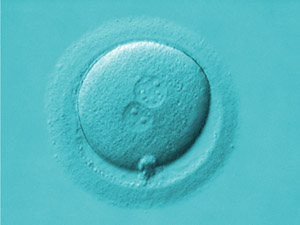 6. Those eggs in which fertilization has adequately taken place will be kept in incubation in an ambience especially adapted to its metabolic and nutritional requirements.
6. Those eggs in which fertilization has adequately taken place will be kept in incubation in an ambience especially adapted to its metabolic and nutritional requirements.
| The embryologist evaluates the development of the embryos each day, taking into account the division pace and the morphology. The embryos are normally transferred on day 3, although sometimes it can be prolonged up to day 5 to carry more selective criteria. |
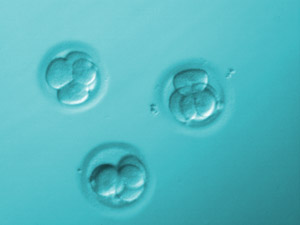 |
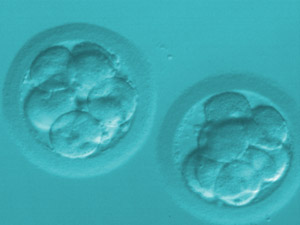 |
| In these cases the embryos will be submitted to a prolonged growth program up to day 5 which corresponds to the blastocyst stage. |
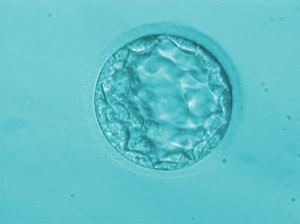 |
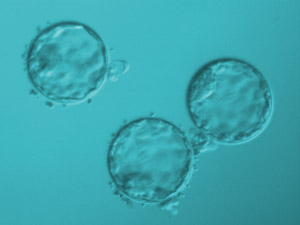 |
7. Embryonic transference is the procedure in which the selected embryos are deposited in the maternal uterus. It is done be means of a catheter which is carefully inserted into the woman’s cervical channel. The transference is done in the operating theatre with the objective of maintaining adequate conditions from the IVF laboratory.
8. The spare good quality embryos will be vitrified. This will allow the couple to have them whenever they desire for a new embryonic transfer.




